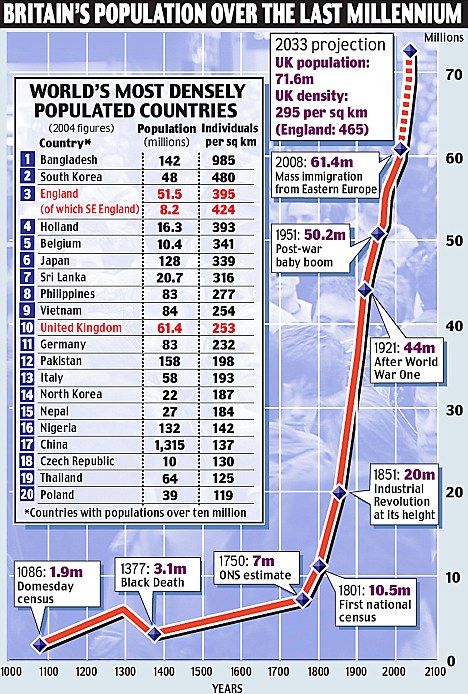 Britain’s population is rising at a speed unprecedented in history, official figures revealed yesterday.
Britain’s population is rising at a speed unprecedented in history, official figures revealed yesterday.
It will pass the milestone of 70million – the point Immigration Minister Phil Woolas promised would never happen – in 20 years.
The Office for National Statistics said that by 2033 there will be ten million more people in the country than now. More than two thirds of the increase, seven million, will be either migrants or the children of migrants, its report said.
This will put pressure on housing, transport, water and key public services.
According to the projections, the bulk of the population increase – 9.2million by 2033 – will be in England. Growth in Scotland, Wales and Northern Ireland is likely to be less than a million.
England is already the third-most-crowded major country in the world and the most crowded country in Europe except for the island of Malta, according to British and UN figures.
Most immigrants gravitate to London and the South East, which is by far the most populous part of the country.
Chris Huhne, home affairs spokesman for the Liberal Democrats, yesterday warned that these areas are now at “the limit of environmental sustainability.”
Despite claims by Labour ministers that population growth is slowing because immigration is on a downward trend, the ONS said that for the foreseeable future the population will grow by 180,000 a year because of higher numbers of immigrants over emigrants. Two years ago the state statisticians put the immigration gain at 190,000 a year.
The ONS forecast contradicts claims by Mr Woolas, who a year ago said: “At some point we will be able to set a limit on migration. This Government isn’t going to allow the population of this country to go up to 70million. There has to be a balance between the number of people coming in and the number of people leaving.”
In July this year, Home Secretary Alan Johnson told the Home Affairs Select Committee: “I do not lie awake at night worrying about a population of 70million. I’m happy to live in a multicultural society where we not only welcome those coming to live and work in this country, but where we can go and live and work in other countries.”
Guy Goodwin, director of population statistics at the ONS, said: “The additional numbers are the equivalent of taking the current population of Scotland, Wales and most of Northern Ireland and putting it into England. The population is projected to increase by 420,000 a year, which is the equivalent of adding the population of Bristol to the UK every year. Whereas it took 57 years for the population to get from 50million to 60million, it is projected to take 24 years to get from 60million to 70million.”
The population reached 50million in 1948 and 60million in 2005. If the ONS projections prove accurate, in 2033 there will be 465 people for every square kilometre in England, and 295 for every square kilometre in the UK.
Peter Madden of Forum for the Future, an environmental group launched by one-time Government adviser Sir Jonathon Porritt, warned: “Population growth will put greater pressure on our public services and increase competition for housing. Protecting our environment and meeting climate change targets will become even harder. And unless it is handled properly, social cohesion will suffer. These projections are a wake-up call for politicians.”
However, Mr Woolas insisted: “The projections show that population growth is starting to slow down. The impacts of the radical reforms we have made to the immigration system over the last two years are working. Last year saw a 44 per cent fall in net migration and we expect that fall to be sustained and reflected in future projections. Our new flexible points-based system is giving us greater control on those coming to work or study from outside Europe, ensuring that only those that Britain need can come.”
Tory immigration spokesman Damian Green said: “This shows how irresponsible Alan Johnson was when he said that he did not lie awake at night worrying about a population of 70million. The failure of Labour to control immigration has left us in this difficult position. A Conservative government would introduce a limit on the numbers allowed to come here to work, as well as other measures to fight illegal immigration.”
Labour MP Frank Field and Tory Nicholas Soames, leaders of the cross party Group on Balanced Migration, said: “We are on course for an unsustainable and unacceptable rise in population. If politicians want to rebuild trust and counter extremism, they must stop ignoring the public’s deep concern about this.”
The number of very old people in the country is expected to more than double over the next two-and-a-half decades, the ONS said. It estimated that there will be 3.3million over-85s by 2033 compared with 1.3million last year. The ranks of people aged over 100 will multiply, with seven time more centenarians, the projections said. There will, according to the estimates, be 80,000 people aged over 100 in 2033 against 11,000 in 2008. Despite the rise in the state pension age, which will be equal for men and women at 66 by 2033, numbers of pensioners will go up sharply. There will be 15.6million by the mid-2030s, the ONS said, compared with 11.8 million now. The increase will mean that everybody of working age will have more pensioners to support. The ratio of working age people to pensioners, currently 3.2 workers for each pensioner, will drop to 2.8 workers for each pensioner in 2033. But without the increase in the age at which people are expected to retire, there would have been only 2.2 workers available to support each pensioner.
(This article has been reprinted from the Daily Mail 22nd October 2009)
Speaking the Truth unto the Nation
